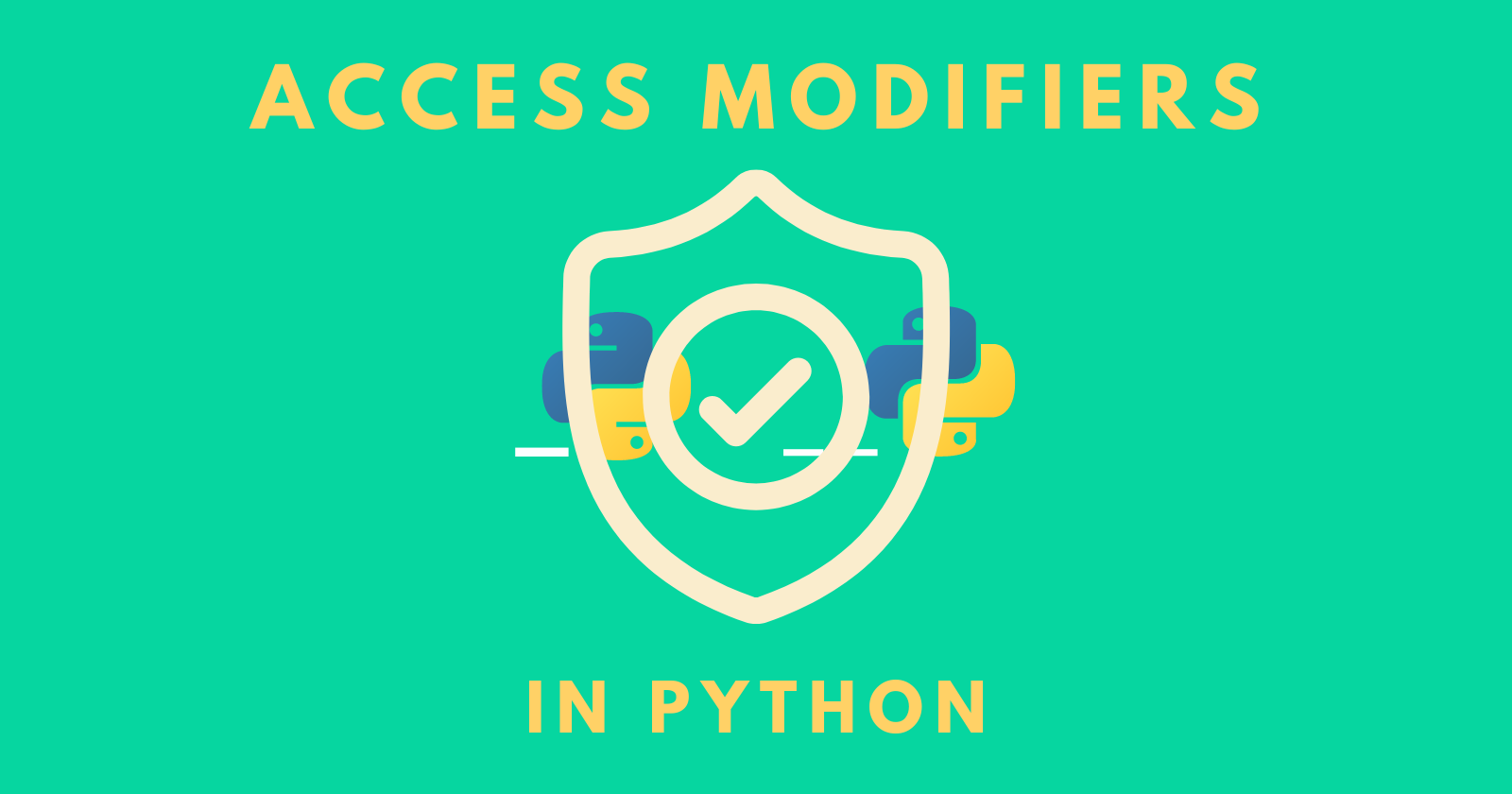Python is an object-oriented programming (OOPs) language in which Classes are integral. Classes are so powerful in object-oriented programming that we can perform high-level tasks like inheritance, abstraction, encapsulation, and polymorphism.
In short, Python classes provide a way to organize code, encapsulate data and behavior, create reusable templates for objects, and implement inheritance. Classes offer a powerful way to organize and manage complex code, promote reusability and make the code easier to read and understand.
We can control the access of the variables and methods inside the Python classes. Access modifiers are used to control access to the variables and methods.
Access modifiers
Access modifiers play an important role in securing the data from unauthorized access and preventing any data exploitation.
Using the underscore (_), we can control access to the data inside the Python classes. Python Class has three types of access modifiers:
- Public Access Modifier
- Private Access Modifier
- Protected Access Modifier
Let’s understand those above-mentioned access modifiers one by one.
Public Access Modifier
The name “Public” says all about this access modifier the variables and methods declared inside the specific Python class can be accessed by that class and any Python class outside that specific class.
Public methods are accessible outside the class and with the help of objects the public methods can be invoked inside the class.
All the variables and methods in a Python class are public by default and just like mentioned above can be accessed from outside the class environment. Here’s an example that will help us understand better.
|
1 2 3 4 5 6 7 8 9 10 11 |
class Hero: def __init__(self, real_name, reel_name, hero_name): self.real_name = real_name self.reel_name = reel_name self.hero_name = hero_name hero = Hero("RDJ", "Tony Stark", "Iron Man") print("Real name: ", hero.real_name) print("Reel name: ", hero.reel_name) print("Hero name: ", hero.hero_name) |
In the above code, we defined a Python class named Hero in which we created a constructor that accepts three arguments named real_name, reel_name, and hero_name.
Then we created a variable called hero outside the class and instantiated the class Hero with corresponding arguments and then printed the values.
|
1 2 3 |
Real name: RDJ Reel name: Tony Stark Hero name: Iron Man |
Here, real_name, reel_name and hero_name are public data members and can be used anywhere in the program. We can also create a public member function inside the class and access it. The following example will show how to do it.
|
1 2 3 4 5 6 7 8 9 10 11 12 13 |
class Hero: def __init__(self, real_name, reel_name, hero_name): self.real_name = real_name self.reel_name = reel_name self.hero_name = hero_name def display_name(self): print("Real name :", self.real_name) print("Reel name :", self.reel_name) hero = Hero("Chris Evans", "Steve Rogers", "Captain America") hero.display_name() print("Hero name: ", hero.hero_name) |
In the above code, display_name is a public member function and we accessed it outside the class. The code will run without any errors.
|
1 2 3 |
Real name : Chris Evans Reel name : Steve Rogers Hero name: Captain America |
We can use these variables in other functions also and the following code shows how to do it.
|
1 2 3 4 5 6 7 |
def access_public_data(): x = Hero("Andrew Garfield", "Peter Parker", "Spider-man") print("Real name: ", x.real_name) print("Reel name: ", x.reel_name) print("Hero name: ", x.hero_name) access_public_data() |
We created a function called access_public_data and instantiated the class Hero which we made earlier and passed the required arguments and called that function. Since the variables inside the Hero class are public, the code will run without any error.
|
1 2 3 |
Real name: Andrew Garfield Reel name: Peter Parker Hero name: Spider-man |
Protected Access Modifier
Protected variables and methods are accessible within the specific class environment and can also be accessed by the sub-classes. We can also say that it allows the resources of the parent class to be inherited by the child class.
Any variables or methods prefixed with a single underscore (_) in a class are protected and can be accessed within the specific class environment. The protected variables/methods can be accessed inside the sub-classes of the parent class.
Here is a code to make protected variables/methods inside the Python class.
|
1 2 3 4 5 6 7 8 9 10 11 12 |
class Anime: _rating = "Best" def __init__(self, anime, release_year): self._anime = anime self._release_year = release_year def _show(self): print("Release:", self._release_year) obj = Anime("Naruto", 2002) print("Anime:", obj._anime) obj._show() |
In the above code, _anime and _release_year which are protected instance variables inside the class Anime as well as it has a protected function called _show.
In the next block of code, we instantiated the class Anime and passed the required arguments and stored them inside the object named obj then displayed the result by calling the protected function and variable.
|
1 2 |
Anime: Naruto Release: 2002 |
We can also access these protected instance variables and protected functions inside the derived class.
|
1 2 3 4 5 6 7 8 9 10 11 |
# Derived class class Other_Anime(Anime): def __init__(self, anime, year): Anime.__init__(self, anime, year) def show_anime(self): print("Anime:", self._anime) self._show() x = Other_Anime("Demon Slayer", 2019) x.show_anime() |
In the above code, the class Other_Anime is created which inherits the class Anime and we defined the public function named show_anime that accesses the protected variables of the class Anime.
We called the public function to display the result from the protected variables.
|
1 2 |
Anime: Demon Slayer Release: 2019 |
You might be thinking that protected variables of the class Anime were also accessible outside the class environment. The protected variables and functions can be accessed by the derived classes and any other classes but it is the sole responsibility of the good programmer not to use the protected data members outside the specific class environment.
Private Access Modifier
As we can tell by seeing its name the “Private” access modifier restricts the variables and methods declared inside the specific class to that class environment.
Simply put, the variables and methods declared inside a class can be accessed inside that class environment and not outside that class. Python doesn’t have any mechanism restricting access to the variables or methods.
But there is a way by which we can impose restrictions to access the variables and methods in Python. Python suggests using a double underscore to imitate the behavior of the private access modifier.
Variables and methods prefixed with a double underscore (__) make them private and cannot be accessed outside the specific class. Let’s understand it with an example.
|
1 2 3 4 5 6 7 8 |
class Superhero: __hero = "Iron Man" def __init__(self, name): self.__name = name obj = Superhero("Shaktiman") print(obj.__name) |
In the above code, the class Superhero is created and we created the private variable named __hero and a private instance variable named __name. Then we instantiated the class and passed the required arguments and tried to access the private data.
|
1 2 3 4 |
Traceback (most recent call last): ... print(obj.__name) AttributeError: 'Superhero' object has no attribute '__name' |
We got the AttributeError saying that the class Superhero has no attribute called __name and it happened because the private data in a class cannot be accessed outside the class. But we can access the private variables and methods inside the class.
|
1 2 3 4 5 6 7 8 9 |
class Superhero: def __init__(self, name): self.__name = name def displayname(self): print("Hero:", self.__name) obj = Superhero("Shaktiman") obj.displayname() |
In the above code, we created a public function called displayname that accesses the private variable __name inside the class and we tried to print the output.
|
1 |
Hero: Shaktiman |
The code ran without any error and we got the output that we expected.
Python prevents private data from accessing outside the class so it does name mangling which means that it changes the process of accessing private data.
We can access the private data from the class and the following example will show you how to do it.
|
1 2 3 4 5 6 7 8 9 |
class Superhero: __hero = "Iron Man" def __init__(self, name): self.__name = name obj = Superhero("Shaktiman") print(obj._Superhero__name) print(obj._Superhero__hero) |
We tried the name-mangling process that helps us access the variables outside the class. We added the _Superhero which is the name of our base class and then added the private variable to the class object obj.
|
1 2 |
Shaktiman Iron Man |
We successfully accessed the __name and __hero variables outside the class.
Conclusion
Python uses a specific naming convention to make any variables/methods protected and private inside the class and all the variables and methods defined inside the Python class are public by default.
Public data attributes are accessible by any class and function, protected data attributes should only be accessed inside the class environment and can also be accessed inside the sub-classes and private data attributes are only accessible inside the class.
We have learned about the public, protected, and private access modifiers that are used to impose restrictions on accessing the variables and methods of the Python class.
🏆Other articles you might like if you liked this article
✅A modern way to perform string interpolation using f-string in Python.
✅Integrate the PostgreSQL database with Python.
✅Build a custom deep-learning model using the transfer learning technique.
✅8 different ways by which you can reverse a Python list.
✅Powerful one-liners in Python to enhance your code.
✅Take multiple inputs from the user in a single line in Python.
That’s all for now
Keep Coding✌✌





